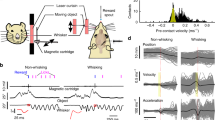Abstract
Experiments performed on decerebrate cats showed that afferent activity accompanying scratching consists of two components—one with a tonic and the other with a periodic phase. The first of these is determined by limb position and the second closely related to speed and amplitude of angular changes occurring at the joints. Peak integral afferent activity within the cycle occurred at the end of the scratch phase itself, when aiming muscles are already operating. These two components of afferent activity produce corresponding changes in depolarization at primary afferent terminals (DPA), which are added to those DPA changes brought about by the effects of the central generator. Statistical relationships between the aforementioned processes were investigated. Mechanisms underlying afferent control over the operation of the scratch generator are discussed.
Similar content being viewed by others
Literature Cited
K. V. Baev, “Central program of hindlimb muscle activation during scratching in the cat,” Neirofiziologiya,13, No. 1, 48–56 (1981).
K. V. Baev, “Active selection of afferent information—the underlying principle of peripheral correction to the operation of spinal rhythmic motion generators,” Neirofiziologiya,16, No. 3, 343–353 (1984).
K. V. Baev, and V. B. Esipenko, “Depolarization of primary afferent terminals during naturally-occurring scratching in the cat,” Neirofiziologiya,17, No. 1, 121–124 (1985).
V. B. Esipenko, “The relationship between hindlimb movement kinematics and afferent activity during scratching in the decerebrate cat,” Neirofiziologiya,19, No. 4, 525–533 (1987).
Yu. P. Shimanskii and K. V. Baev, “Relationship between parameters of efferent activity and limb position during fictive scratching in the decerebrate cat,” Neirofiziologiya,18, No. 5, 636–645 (1986).
Yu. P. Shimanskii and K. V. Baev, “Reordering of efferent scratch generator activity produced by phasic stimulation of hindlimb muscle afferents in the decerebrate immobilized cat,” Neirofiziologiya,19, No. 3, 372–382 (1987).
Yu. P. Shimanskii and K. V. Baev, “Reordering of efferent scratch generator activity produced by phasic stimulation of hindlimb cutaneous afferents in the decerebrate immobilized cat,” Neirofiziologiya,19, No. 3, 382–390 (1987).
K. V. Bayev (Baev) and P. G. Kostyuk, “Primary afferent depolarization evoked by the activity of spinal scratching generator,” Neuroscience,6, No. 2, 205–215 (1981).
T. G. Deliagina, A. G. Feldman, J. M. Gelfand, and G. N. Orlovsky, “On the role of central program and afferent inflow in the control of scratching movements in the cat,” Brain Res.,100, No. 2, 297–313 (1975).
Additional information
A. A. Bogomolets Institute of Physiology, Academy of Sciences of the Ukrainian SSR, Kiev. Translated from Neirofiziologiya, Vol. 20, No. 1, pp. 49–57, January–February, 1988.
Rights and permissions
About this article
Cite this article
Baev, K.V., Esipenko, V.B. Changes in the intensity of integral afferent inflow from limb receptors and in primary afferent terminal polarization during scratching in the decerebrate cat. Neurophysiology 20, 39–46 (1988). https://doi.org/10.1007/BF02198424
Received:
Issue Date:
DOI: https://doi.org/10.1007/BF02198424




